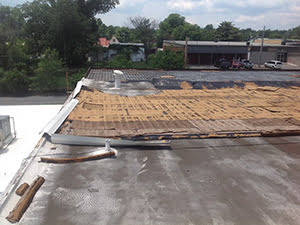
When severe weather strikes, commercial property owners often face significant challenges with roof storm damage. Navigating insurance claims for storm-damaged commercial roofs requires understanding your policy, documentation requirements, and the claims process. This guide covers essential information to help business owners maximize their insurance coverage and protect their investments.
Protecting Bismarck, ND commercial buildings is Eagle Eye Roofing Systems primary focus. With an eye on getting the most from your roofing system, we are proud to partner with you for all your commercial roofing needs. Call 701-202-7280 today to schedule your consultation.
Common Types of Roof Storm Damage
Commercial roofs are vulnerable to various types of storm damage:
- Wind damage can lift or tear away roofing materials
- Hail impacts can create punctures or weaken roofing membranes
- Heavy rainfall can lead to leaks and water infiltration
- Debris impact from broken tree limbs or flying objects
- Snow and ice accumulation causing structural stress
Understanding Your Commercial Insurance Policy
Most commercial property insurance policies cover storm damage, but coverage details vary significantly. Review your policy for:
- Coverage limits for roof replacement versus repair
- Age-based depreciation schedules that may reduce payouts
- Special endorsements for wind and hail damage
- Deductible amounts specific to storm-related claims
- Excluded perils or weather events
Many commercial policies have moved to actual cash value (ACV) coverage for older roofs rather than replacement cost value (RCV), significantly impacting claim settlements.

Documenting Commercial Roof Damage
Proper documentation strengthens your insurance claim:
- Take extensive photos and videos of all damaged areas
- Document the date and nature of the storm event
- Secure emergency repairs to prevent further damage
- Maintain records of all communications with insurers
- Get professional roof inspections from qualified contractors
The Commercial Roof Claim Process
When filing a commercial roof claim:
First, report the damage promptly to your insurance company. Most policies have strict time limitations for storm damage claims.
Next, meet with the insurance adjuster during their inspection. Having your roofing contractor present during this assessment can help identify all damage points.
Review the settlement offer carefully. If it seems inadequate, you have the right to dispute the valuation and request a re-inspection.
Roof Storm Damage Professionals
Working with roofing contractors experienced in commercial insurance claims can significantly improve outcomes. These professionals understand insurance terminology and can help ensure all damage is properly identified and valued.
Consider consulting with a public adjuster if facing a complex or high-value claim denial. These licensed professionals represent policyholders rather than insurance companies.
Regular roof maintenance and documentation of your roof’s condition before storm damage occurs creates valuable baseline evidence for future claims.
Understanding your rights and responsibilities under your commercial insurance policy empowers you to advocate effectively for proper coverage of storm-damaged roofs, protecting both your property and financial interests.
To learn more ways to protect your Bismarck, ND commercial investment, call 701-202-7280 and speak with one of our experts.
Commercial Roof Storm Damage FAQs
How quickly should I file an insurance claim after storm damage to my commercial roof?
You should file a claim as soon as possible after discovering damage. Most commercial insurance policies have specific timeframes (typically 30-60 days) for reporting storm damage. Delayed reporting can result in claim denial, especially if the delay leads to additional damage.
Can insurance companies deny my claim based on roof age or pre-existing conditions?
Yes. Insurance companies commonly deny claims if they determine the damage resulted from poor maintenance, pre-existing issues, or normal wear and tear rather than storm damage. Many policies also contain age-based depreciation schedules that reduce coverage for older roofs, sometimes excluding roofs beyond a certain age entirely.
What’s the difference between cosmetic and functional roof damage for insurance purposes?
Functional damage affects your roof’s ability to protect the building from the elements, while cosmetic damage only impacts appearance. Many commercial policies now exclude coverage for cosmetic damage, particularly for metal roofing systems with visible hail denting that doesn’t compromise functionality.
Should I get multiple repair estimates before filing a commercial roof damage claim?
While not required, obtaining 2-3 estimates from reputable commercial roofing contractors before filing can strengthen your claim. Multiple consistent estimates demonstrate the legitimacy of repair costs and provide valuable documentation if the insurance adjuster’s assessment differs significantly.
How can I appeal an undervalued or denied commercial roof claim?
If your claim is denied or undervalued, you can request a re-inspection with a different adjuster, provide additional documentation of damage, hire a public adjuster to represent your interests, or invoke your policy’s appraisal clause. In some cases, consulting an attorney specializing in insurance law may be necessary for significant claim disputes.
